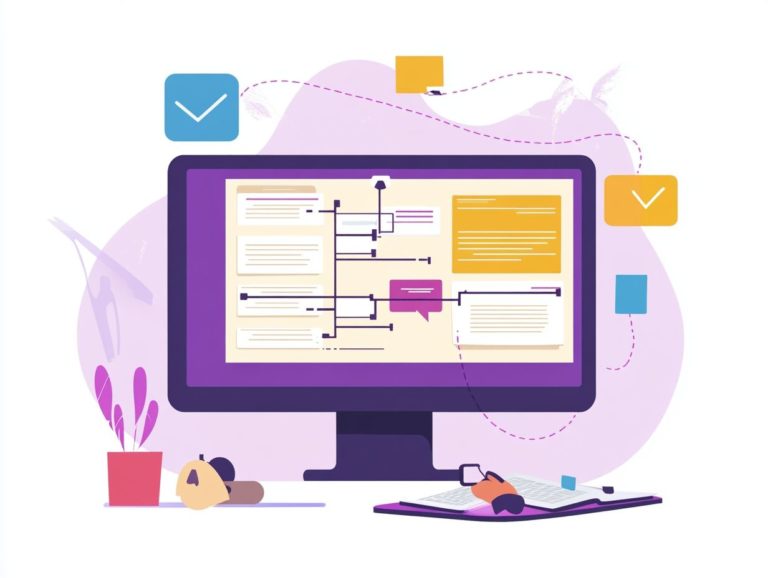How to Document Your Migration Process
In today s fast-paced digital landscape, effective migration processes are essential for businesses aiming to remain competitive. Without proper documentation, migrations can spiral into chaos and become riddled with errors.
This article explains why documentation is crucial during migration. It will guide you in creating a solid plan, identifying key information, and choosing the right tools.
You ll find a step-by-step guide designed to streamline your process, along with best practices for organizing your documentation and strategies to keep it current.
It also addresses common challenges and offers solutions to help you through them. Are you ready to supercharge your migration process? Let s get started!
Contents
- Key Takeaways:
- Understanding the Importance of Documentation
- Creating a Plan for Documentation
- Step-by-Step Guide for Documenting Your Migration Process
- Organizing and Storing Your Documentation
- Reviewing and Updating Your Documentation
- Common Challenges and Solutions for Documenting Migrations
- Frequently Asked Questions
- What is the purpose of documenting your migration process?
- What should be included in the documentation of a migration process?
- How should the documentation be organized?
- Who should be responsible for documenting the migration process?
- Is it important to update the documentation during the migration process?
- How long should the documentation of the migration process be kept?
Key Takeaways:

- Proper documentation is crucial for a successful migration.
- Before starting, create a documentation plan.
- Organize your documentation for easy access.
- Regularly review and update for accuracy.
Understanding the Importance of Documentation
Recognizing the importance of documentation in the data migration process is essential for achieving a seamless transition, particularly when moving to cloud environments or managing legacy systems.
Thoughtful documentation acts as a roadmap, guiding you and your team through the intricacies of data extraction, loading, and transformation. This proactive approach minimizes data quality issues and significantly enhances the efficiency of your migration efforts.
Why Documenting Your Migration Process Matters
Documenting your migration process enhances its efficiency, enabling you to track continuous data migration and synchronization between systems with ease.
This meticulous documentation serves as a vital reference point throughout both the pre-migration and post-migration phases, minimizing potential errors and ensuring every stakeholder is aligned with the strategy.
By clearly outlining workflows, dependencies, and configurations, you can anticipate challenges in advance, streamline communication, and adapt swiftly to any issues that arise.
When paired with migration tools, this documentation allows for more effective use of automated functionalities, facilitating a smoother data transition.
The synergy between thorough documentation and robust migration tools ultimately leads to a successful and less disruptive migration journey.
Creating a Plan for Documentation
Crafting a comprehensive documentation plan is vital for a successful data migration. This entails outlining a clear migration strategy that aligns with the defined project scope, evaluating storage options, and meticulously planning resources.
By doing so, you ensure a seamless transition and minimize potential pitfalls along the way.
Identifying Key Information to Document
Identifying key information to document requires keen focus on essential elements like data details management, file types, and document formats all critical to the migration process.
It s equally crucial to capture details related to data volume, user access rights, and the interdependencies among various systems.
Utilizing data profiling tools tools that analyze data quality allows you to gain insights into existing data quality and spot potential issues before making any moves.
Ensuring robust backup data options means that no critical information gets lost during the transition.
Each of these components not only smooths out the migration but also mitigates risks, making the entire process more efficient.
By prioritizing these aspects, you can significantly enhance your chances of achieving a seamless transition while safeguarding your vital assets.
Start documenting your migration journey today for a smoother transition tomorrow!
Tools and Methods for Documentation

Using the right tools and methods boosts the efficiency of your migration process. This is especially true for tools that extract, transform, and load data (ETL) and migration solutions for cloud applications.
In today s data-driven landscape, integrating various ETL platforms enables seamless data extraction, transformation, and loading. These tools streamline your data processes and offer essential reporting features to maintain comprehensive documentation throughout your migration journey.
Never underestimate the importance of robust customer support; it ensures prompt resolution of any issues or questions that may arise.
Implement effective testing solutions and monitor your data migration. This proactive approach helps identify issues early, safeguarding data integrity and ensuring a successful migration outcome.
Step-by-Step Guide for Documenting Your Migration Process
A comprehensive step-by-step guide for documenting your migration process is crucial for clarity and consistency. This is especially important during complex database and cloud migrations, whether you choose a big-bang approach or prefer incremental migrations.
Breaking Down the Process into Manageable Steps
Breaking down the migration process into manageable steps allows you to tackle potential data quality issues head-on. This ensures effective data synchronization during continuous data migration.
This structured approach includes key stages: planning, data assessment, mapping, migration, and validation. At each stage, it s essential to rigorously test solutions to uncover any shortcomings early, preventing complications later on.
Documenting your findings and challenges not only refines your strategies but also serves as a valuable reference for future migrations. By keeping clear records, your team can make informed decisions while navigating unforeseen obstacles, paving the way for a smoother transition and enhanced data integrity across systems.
Organizing and Storing Your Documentation
Organizing your documentation is key! It ensures quick access and helps you stay on top of your migration game. This is crucial when utilizing a document management system to facilitate storage migration and uphold best practices throughout the process.
Best Practices for Organizing and Accessing Your Documentation
Implement best practices for organizing and accessing your documentation to maintain standards in document formats. Ensure that appropriate access permissions are established for team members involved in data migration.
When you prioritize clear organization, your team can swiftly access critical information. This is vital for making real-time decisions during the migration process. Defining strict access permissions protects sensitive data and fosters accountability among team members.
Effective data governance is vital. It establishes the protocols needed for proper data usage and protection. By adopting these practices, your organization can streamline workflows, reduce errors, and enhance the overall efficiency of monitoring activities throughout the migration journey.
Reviewing and Updating Your Documentation

Regularly reviewing and updating your documentation is crucial! This ongoing commitment ensures the information remains relevant and accurate.
This practice is essential for effectively managing data quality issues and providing exceptional customer support throughout and after the migration process.
How to Keep Your Documentation Relevant and Accurate
To keep your documentation relevant and accurate, implement feedback mechanisms. Continuous improvement strategies are essential, especially for managing problems that affect the accuracy of data and conducting regular audits.
Utilizing tools like surveys and feedback forms can effectively gather valuable insights from users and stakeholders. This enables you to make adjustments based on real-world experiences.
Conducting regular review meetings facilitates open discussions about documentation accuracy. This ensures that any issues with data management are addressed promptly.
These strategies not only enhance the clarity of your documentation but also promote a culture of accountability within your organization.
A robust data governance framework supports the maintenance of accurate logs. It simplifies the tracking of changes and updates, fostering trust in the data management process.
Common Challenges and Solutions for Documenting Migrations
You may encounter common challenges during the documentation of migrations, such as the risks of data loss or the lack of comprehensive migration roadmaps.
Addressing these issues often necessitates proactive troubleshooting and tailored solutions. This is crucial for both the success of your project and the effectiveness of customer support.
Troubleshooting Issues and Overcoming Obstacles
Navigating the troubleshooting landscape during the migration documentation process requires upholding strong data management while fostering team collaboration to tackle common issues effectively.
To elevate this process, consider implementing specific practices such as:
- Setting clear documentation standards,
- Conducting regular audits for accuracy,
- Utilizing collaborative tools for real-time updates.
Create an atmosphere where team members feel encouraged to share their insights and suggestions. This helps maintain the integrity of the documentation and results in fewer errors and inconsistencies.
Provide regular training on best practices and tools. This arms your team with the knowledge needed to proactively address challenges and streamlines workflows. It also ensures reliable records throughout the migration cycle.
Frequently Asked Questions
What is the purpose of documenting your migration process?

Documenting your migration process is important because it provides a detailed record of the steps taken during the migration. This makes it easier to troubleshoot any issues that may arise and to replicate the process in the future.
What should be included in the documentation of a migration process?
The documentation should include a list of all the systems and applications being migrated, the specific data being transferred, the timeline of the migration, any troubleshooting steps taken, and any changes made during the process.
How should the documentation be organized?
The documentation should be organized in a clear and logical manner. Each step of the migration process should be documented chronologically. Including screenshots, diagrams, and other visual aids can make the documentation more comprehensive.
Who should be responsible for documenting the migration process?
Assign someone knowledgeable about the systems and applications being migrated to document the migration process. This person should have a good understanding of the migration process.
Is it important to update the documentation during the migration process?
Yes, update the documentation during the migration process. Any changes or issues that arise should be noted. This ensures that the final documentation accurately reflects the entire migration process.
How long should the documentation of the migration process be kept?
Keep the documentation for as long as the systems and applications remain in use. This ensures that it is available for future reference and can be used to troubleshoot any issues that may arise.






